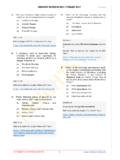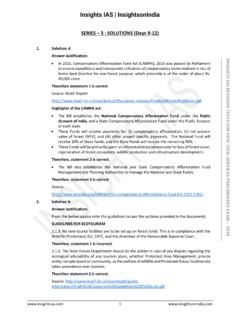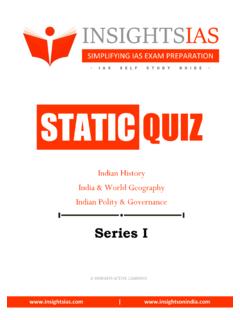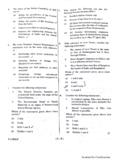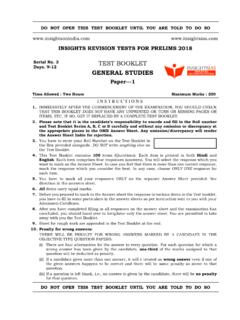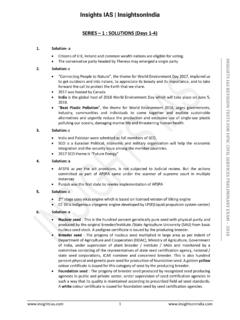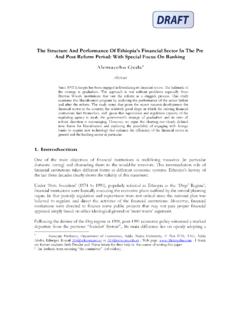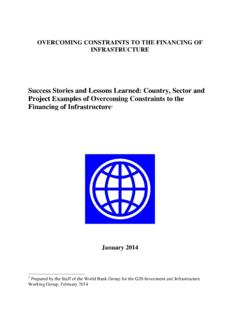Transcription of Insights into Yojana: January 2018 - …
1 Insights into Yojana: January 2018 Banking Reforms W W N S I G H T S O N I N D I O M Insights into Yojana: January 2018 Page 2 Table of Contents 1. Banking Sector Reforms: Ensuring 2. Managing Non-Performing Assets: A Paradigm 3. Facilitating Financial 4. Resolving 5. Strengthening of Cyber 6. Rural Banking: Translating Vision to 7. A New Dimension in Highway 8. India s Credit Rating: Boost to Investors 9. Facts for Prelims a. Cabinet approves India's Membership for European Bank for Reconstruction & b. National Nutrition c. Haircuts in the Banking d. Schemes for Women e.
2 National Trachoma Survey Report (2014-17)..18 f. Loan Agreement with World Bank for SANKALP East Diary a. Tuirial Hydroelectric Power b. NLCPR scheme for North Insights into Yojana: January 2018 Page 3 Banking Sector Reforms: Ensuring Regulation Introduction For both firms and households, the banking system is one of the most important sources of credit in India. The size, resilience and level of capitalisation of banks are critical for the smooth functioning of financial markets. Key challenges to the banking system include low financial depth, a high share of NPAs and a high concentration of Public sector banks (PSBs).
3 These issues constrain international credit and banks ability to meet international capital requirements. We need to focus on three areas to stimulate the banking sector: o Improving governance of banks, o Enhancing competition in the sector, o Developing corporate bond markets to relieve pressure from banks as lending sources. The Current Situation PSBs are the biggest contributors to the large and rising stock of NPAs. Gross NPAs in PSBs rose from Rs. lakh crore in March 2015 to Rs. lakh crore in June 2017. Even private banks have been plagued by a high share of NPAs. The decline in banks profits is largely due to higher growth in risk provisions, loan write-offs and decline in net interest income.
4 The stress on the banking sector has translated into a slowdown in industrial credit. They also limit banks ability to meet international capital requirements under Basel III. The Indradhanush plan will not only help PSBs meet their minimum capital requirements but they will also help banks clean up their balance sheets and cover bad loans. It also includes wider banking reforms needed to strengthen institutional governance. The Insolvency and Bankruptcy Code (IBC) provides a channel for addressing NPAs. It requires banks and promoters to agree on a resolution plan within 270 days or face asset liquidation. Global Competition India s banks lag behind global banks in terms of financial depth or the size of banks and markets relative to economic output.
5 India has low levels of private credit to GDP and credit to deposit ratio, relative to other emerging economies. Since 1991, only 14 licences have been granted for universal banks. In contrast, in the US, over 130 new banks were charted annually on average between 1976 and 2009. Looking Ahead India should strive to have a more robust and well capitalised banking system, with enhanced capacity to extend credit and productive allocation of resources. To build a robust banking system, recapitalisation will have to be complemented by other measures like corporate governance reforms, lower entry barriers, improved financial supervision, development of a dynamic corporate debt market and efficient debt recovery mechanisms.
6 Global examples highlight the importance of undertaking banking sector reforms in tackling NPAs. Insights into Yojana: January 2018 Page 4 o In China, besides recapitalisation, banking sector reforms focused on strengthening financial regulation and supervision, improving corporate governance and enhancing transparency. o South Korea created a Financial Supervisory Service (FSS) to ensure supervision in their banks following the East Asian Financial Crisis of the late 1990s. Greater accountability can ensure that banks lending practices are in line with the productive allocation of credit. Corporate bond markets need to complement banks as important sources of finance.
7 India should continue to encourage the entry of private and foreign players to foster greater competition and innovation in the sector. The new policy of on-tap licensing of banks is a positive step in this direction. The entry requirements could be relaxed further to reduce barriers to entry. Questions 1. It is said that the union government wants to privatise public sector banks. Discuss the arguments made in favour of and against privatisation of public banks. 2. In your opinion, what reforms should be introduced to prevent crisis in public sector banks. 3. It is said that India s public sector banks are facing a serious existential crisis. Why healthy public sector banks are necessary for India?
8 What are the causes of and remedies for their crisis? Critically examine. 4. Analyse the methods adopted to recapitalise weak public sector banks (PSBs) in India and the challenges faced in recapitalisation. 5. Critically evaluate the performance of Public Sector Banks (PSBs) and the factors that are responsible for their high stressed assets. Also comment if it is fair to compare and contrast their performance with that of private banks ? 6. With reference to the SARFAESI Act, consider the following statements: 1. The moment a high-value borrower fails to pay the EMI, a bank resort to actions under this act 2. The act applies only to those assets that have been mortgaged by the borrower 3.
9 If a bank fails a minimum of two times to auction the assets, it can go for private treaties Which of the statements given above is/are correct? (a) 1 only (b) 2 and 3 only (c) 2 only (d) None of the above Solution (b) 7. The Government has announced capitalization of PSBs. What are the modes of capitalization planned? 1. Recapitalization Bonds 2. Budgetary Support (a) Only 1 (b) Only 2 (c) Both (d) Neither Solution (c) Insights into Yojana: January 2018 Page 5 Managing Non-Performing Assets: A Paradigm Shift Introduction Financial intermediation by banks is an engine of growth because they cause money to be circulated in the economy by seeking deposits from those who have surplus and lend for investment activity.
10 One major reason for muted credit growth is fast accretion of NPAs on banks balance sheets. Gross NPAs of banks in India as on September 2017 are Rs lakh crore. The rise of NPAs had its genesis in rapid credit growth of banks during the preceding years say from 2008 onwards. Reasons the current state of affairs Exuberance in increasing balance sheet size by lending to borrowers unworthy of such loans on account of their past credit history. Borrowing for creating excess capacities in anticipation of demand without factoring in the global capacities. Project completion was delayed for various reasons. Recovery of receivables was poor. The concerned corporate was not able to raise capital through the issue of equity or other debt instruments from capital markets and used borrowed money as equity lending to double leveraging.

